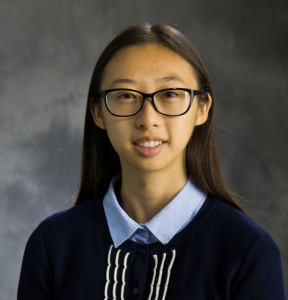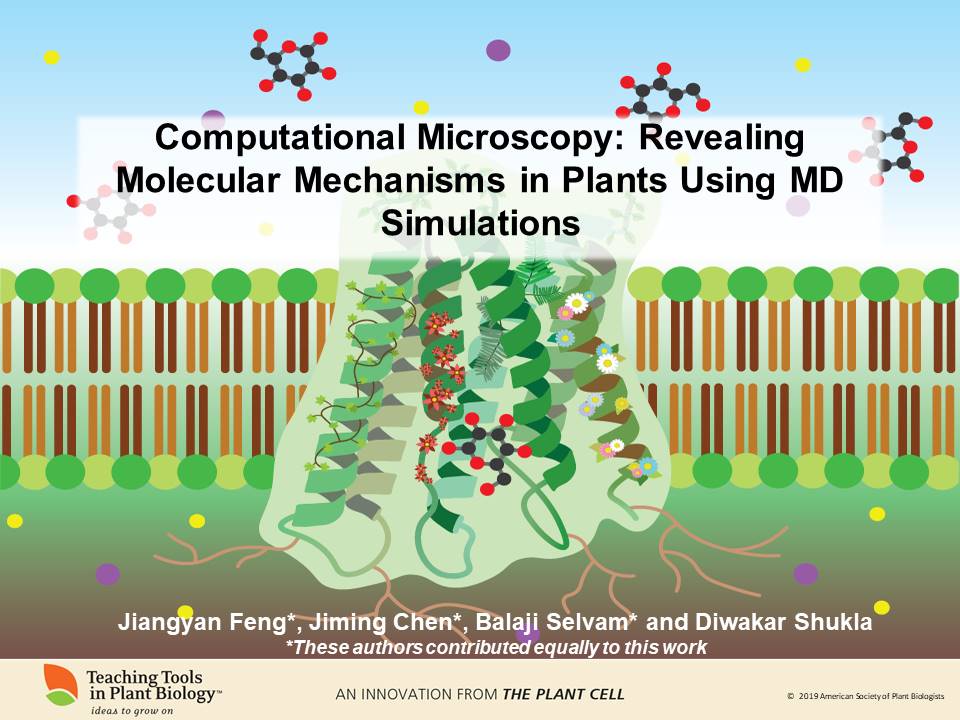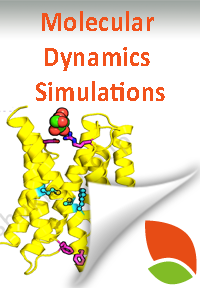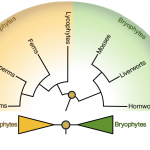New Teaching Tool, “Computational Microscopy: Revealing Molecular Mechanisms in Plants Using Molecular Dynamics Simulations”
We’re excited to annouce the publication of The Plant Cell‘s latest Teaching Tool, “Computational Microscopy: Revealing Molecular Mechanisms in Plants Using Molecular Dynamics Simulations,” by Jiangyan Feng, Jiming Chen, Balaji Selvam, and Diwakar Shukla. Available without subscription at The Plant Cell (soon) and Plantae.org.
Virtually all processes in living organisms, from nutrient transport to the regulation of growth, are mediated by proteins. Gaining a detailed view of the biological processes occurring in plants requires understanding of the structure and function of the proteins involved in these processes. Sequence information is widely available for proteins across organisms, but structural information is still lacking, especially for plant proteins.
Structural biology has provided valuable insights and high-resolution views of the biophysical processes in plants, such as photosynthesis, hormone signaling, nutrient transport, and toxin efflux. However, structural biology only provides a few “snapshots” of protein structure, whereas in vivo, protein function involves complex dynamical processes such as ligand binding and conformational changes that structures alone are unable to capture in full detail.
Here, we present all-atom molecular dynamics (MD) simulations as a “computational microscope” that can be used to capture detailed structural and dynamical information about the molecular machinery in plants and gain high-resolution insights into plant growth and function. In addition to the background information provided here, we have prepared a set of tutorials that allow students to run and explore MD simulations of plant proteins.
Shown below: ABA interaction with receptor protein PYL5.
 Jiangyan Feng is a PhD candidate in the Department of Chemical and Biomolecular Engineering at the University of Illinois. Her research focuses on using molecular dynamics simulations to study the mechanism of nitrogen uptake in plants with the goal of genetically engineering crops to improve nitrogen use efficiency. She previously earned her bachelor’s degree in Chemical Engineering from Tianjin University.
Jiangyan Feng is a PhD candidate in the Department of Chemical and Biomolecular Engineering at the University of Illinois. Her research focuses on using molecular dynamics simulations to study the mechanism of nitrogen uptake in plants with the goal of genetically engineering crops to improve nitrogen use efficiency. She previously earned her bachelor’s degree in Chemical Engineering from Tianjin University.
Jiangyan says, “How do proteins perform remarkably different cellular functions such as signaling, transport, and catalysis? The secret is that proteins are highly dynamic, and the motions often determine their functions. However, structures obtained by X-ray crystallography and cryogenic electron microscopy usually provide single, static snapshots of proteins. In recent years, molecular dynamics (MD) simulations have become a cutting-edge technique to investigate the dynamic motions of macromolecules. I am so excited to bring MD into the view of a broader audience. I believe this tutorial will offer an overview of the role of protein dynamics in its function and the ways to investigate it using MD simulations.”
 Jiming Chen is a PhD student in the Department of Chemical and Biomolecular Engineering at the University of Illinois. Her research focuses on unraveling the molecular mechanism of strigolactone perception in plants. In particular, she is interested in determining the molecular basis for the high sensitivity of strigolactone receptors in the parasitic plant witchweed and ultimately aiding the design of inhibitors to control witchweed germination. Jiming earned her bachelor’s degree in Chemical Engineering from Rice University.
Jiming Chen is a PhD student in the Department of Chemical and Biomolecular Engineering at the University of Illinois. Her research focuses on unraveling the molecular mechanism of strigolactone perception in plants. In particular, she is interested in determining the molecular basis for the high sensitivity of strigolactone receptors in the parasitic plant witchweed and ultimately aiding the design of inhibitors to control witchweed germination. Jiming earned her bachelor’s degree in Chemical Engineering from Rice University.
Jiming says, “Molecular modeling is a powerful set of methods with a lot of potential applications in plant biology, including investigating how plants perceive signals and transport nutrients. One hope I have for this teaching tool is that it helps to provide an opportunity for the plant community to learn about and explore the applications of MD simulations. The amount of available structural data on plant proteins is growing steadily, and integration of this data with MD simulations provides ample opportunities to improve our understanding of how plants operate on a molecular level.”
 Dr. Balaji Selvam is a postdoctoral scholar in the Department of Chemical and Biomolecular Engineering at University of Illinois. His research focuses on mechanistic studies of membrane transporters, including nitrate and sugar transporters in plants. Dr. Selvam earned his PhD at Queen’s University Belfast, where he used computational approaches to study membrane proteins.
Dr. Balaji Selvam is a postdoctoral scholar in the Department of Chemical and Biomolecular Engineering at University of Illinois. His research focuses on mechanistic studies of membrane transporters, including nitrate and sugar transporters in plants. Dr. Selvam earned his PhD at Queen’s University Belfast, where he used computational approaches to study membrane proteins.
Dr. Selvam says, “Molecular dynamics (MD) simulation provides time-dependent motions of the atoms. The sequential snapshots over a period were saved as a trajectory. The visualization of the trajectory helps us to explore, understand and communicate the quantitative information in an effective way. VisualMolecular Dynamics (VMD) developed by the Theoretical and Computational Biophysics (TCB) group from the University of Illinois at Urbana-Champaign provides an excellent tool for visualization and analysis of biomolecular structure & dynamics. The tutorial on the visual molecular dynamics would provide readers an interactive and animated interface for learning about molecular simulations.”
 Prof. Diwakar Shukla is a Blue Waters assistant professor in the Department of Chemical and Biomolecular Engineering at University of Illinois, Urbana-Champaign. He is also an affiliate faculty in Plant Biology, Center for Biophysics and Quantitative Biology, Computational Science and Engineering, the National Center for Supercomputing Applications, and the NIH Center for Macromolecular Modeling and Bioinformatics. His lab focuses on developing and applying computational methods to study the underlying molecular mechanisms of biological processes, such as substrate transport across membranes and cell signaling. Prof. Shukla previously earned his PhD from the Massachusetts Institute of Technology and completed a postdoctoral fellowship at Stanford University.
Prof. Diwakar Shukla is a Blue Waters assistant professor in the Department of Chemical and Biomolecular Engineering at University of Illinois, Urbana-Champaign. He is also an affiliate faculty in Plant Biology, Center for Biophysics and Quantitative Biology, Computational Science and Engineering, the National Center for Supercomputing Applications, and the NIH Center for Macromolecular Modeling and Bioinformatics. His lab focuses on developing and applying computational methods to study the underlying molecular mechanisms of biological processes, such as substrate transport across membranes and cell signaling. Prof. Shukla previously earned his PhD from the Massachusetts Institute of Technology and completed a postdoctoral fellowship at Stanford University.
Diwakar says, “For the use of physics-based computational models to find success in the study of plants, and plant proteins in general, it will be necessary for future generations of plant biologists to be trained in quantitative thinking and methods. As we have pointed out, very little structural and dynamic information exists concerning plant proteins. Researchers with strong backgrounds in physics, mathematics, and computational science will be necessary to uncover the atom-level details of plant protein structural dynamics, and in doing so, guide future crop innovation. This teaching tool is an attempt to showcase one of the popular techniques for interrogating protein dynamics with examples derived from our work on plant membrane transporters and hormone receptors.”

Download all materials here. Data files for the tutorials can be downloaded from here.




